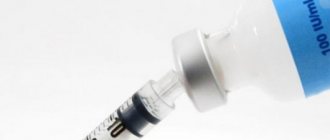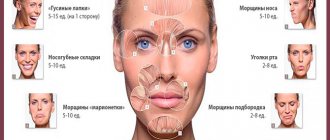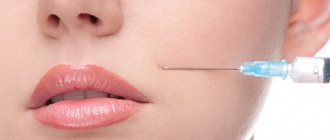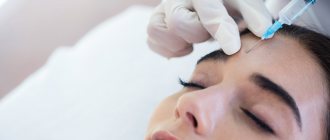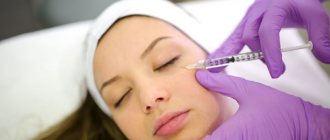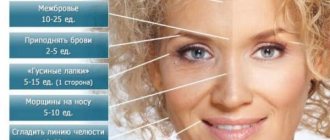Error with drug selection
Botulinum therapy, like any other method of aesthetic medicine, requires an individual approach, and the drug for injection in each specific case must be selected, focusing on the characteristics of the woman - the condition of her skin, the severity of age-related changes, medical history, etc. Currently, specialists have several drugs at their disposal for based on botulinum neurotoxin type A, except for Botox itself, produced in the USA and occupying a leading position in the cosmetic market. The most popular are Dysport produced in France, German Xeomin, Lantox produced in China, as well as domestic drugs Relatox and Botulax. Despite the fact that they have the same active ingredient, each product has individual characteristics associated with production, composition, and application algorithm that distinguish it from analogues. For example, “Xeomin” has the mildest effect, you can inject it more often, it is practically not addictive. But if you have been on the stronger Botox or Dysport for a long time, and then want to switch to Xeomin, the result may disappoint you. But for a woman who has decided to have beauty injections for the first time or if there are few wrinkles, “Xeomin” is perfect. On the other hand, Xeomin is often “prescribed” to those for whom Botox or Dysport have ceased to work, in order to restore tissue sensitivity to botulinum therapy that has been lost over time. The German drug has a different formula - unlike its predecessors, it does not contain unnecessary proteins that burden the immune system and contribute to the development of addiction. “Dysport” has a lower molecular weight, and therefore higher diffusion into tissue. This may increase the incidence of side effects, which also needs to be taken into account when choosing a drug for injection.
It is also the patient’s fault that the botulinum therapy remedy refuses to work, when he does not give the doctor complete, detailed and truthful information about his state of health, chronic diseases, past infections, medications taken, etc.
When to start injecting Botox?
Previously, botulinum therapy procedures—that’s what doctors call Botox injections—were perceived as the tricks of stars or, moreover, exclusively as entertainment for housewives from Beverly Hills. However, in recent years, Botox has become the most popular and widespread anti-aging drug. (Unfortunately, this did not help the myths surrounding this procedure disappear.)
The mirror will tell you when to start injecting Botox! 16587
One way or another, this rejuvenating procedure is characterized by a minimal degree of invasiveness and at the same time gives dramatic, pronounced results. So the question “When should I start injecting Botox?” More and more representatives of the fair sex are being asked, and their age is getting “younger”. But still, what is the correct answer? In fact, you can start injecting Botox at a very young age.
When to start injecting Botox: beauty injections are suitable for all ages
Botox is a drug approved by perhaps the most stringent regulatory body in the world, the FDA. It is a complex of botulinum bacteria toxins, which, when introduced into certain areas of the facial muscles, temporarily blocks local nerve impulses, which for a while (from 3 to 6 months) “turns off” facial expressions and seems to smooth the skin. Also, regular botulinum toxin injections help get rid of bad habits, such as wrinkling your forehead or frowning your eyebrows, which “program” the skin for deep wrinkles. Indeed, as we age, the skin loses its elasticity, as collagen in it is increasingly destroyed - therefore, constant muscle and skin contractions can form deeper wrinkles and folds.
So what time? In fact, the FDA has only approved it for anyone between the ages of 18 and 65. So, technically, Botox can be injected at any age - but only under the supervision of a doctor. Botox smoothes wrinkles by preventing muscle contraction. Historically, its first target was the glabella area. And if you start injecting Botox early enough, at the age of about 30, then you can actually prevent (slow down) the appearance of wrinkles. Don't believe me? And it's worth it! First of all, it should be recalled that botulinum therapy is a method not only for the correction of wrinkles, but also a method for their prevention. So the question is “When should I start injecting Botox?” It doesn’t sound idle even for 20-25 year olds who think ahead and take into account their heredity, type of facial aging, lifestyle and other factors that “transform” the skin not for the better. And for the purpose of prevention, you can start injecting Botox at the age of 30, or just over 20 - it depends on the individual characteristics of each girl.
Now that the practice has become less controversial and the safety of botulinum toxin has been repeatedly confirmed, more and more young and even young women are considering regular injections of Botox or Dysport as a method of preventing aging, and not as an emergency treatment that can smooth out badly wrinkled skin. And experts approve of this trend!
When to do Botox injections. And when you can’t inject Botox. 16553
In fact, the American Society of Plastic Surgeons reports that from 2000 through 2020, plastic surgeons increased the number of such procedures on patients under 30 by 64%. In general, the number of Botox injections during this time has increased by as much as 750 percent! So the “modest” figure of 64%, of course, pales in comparison to the global figure, but you should still know that botulinum toxin injections have their own indications, administration technique and other features for each age. And we should dwell on this point in more detail...
You can start getting Botox at age 20
Some experts in the field of aesthetic medicine recommend using this drug starting from the middle to the end of the third decade. According to them, this helps to more effectively prevent the appearance of wrinkles, as well as overexpression of facial muscles. This, accordingly, reduces the risk of negative effects of other aging factors - genetic, environmental, etc. To avoid frozen faces, dermatologists simply use less botulinum toxin and inject more superficially (the needle does not go deep into the skin) than in older people.
Of course, most women do not notice wrinkles on their faces this decade and not all of them are candidates for botulinum therapy. For most people, it is enough to apply cream with SPF daily to keep their skin fresh and elastic longer. However, if you plan to use Botox in the future, you should think about the formation of wrinkles on the skin in advance: perhaps you should slightly reduce the expressiveness of your facial expressions?
You can start getting Botox at age 30
During this decade, women usually begin to notice the first age-related changes. As for wrinkles themselves, they usually begin to appear in the form of “crow’s feet” around the eyes or fine lines between the eyebrows.
At this age, botulinum toxin will soften these first signs of aging and even help “erase” many of the fine lines. The main thing is to maintain a regular injection regimen (every three months or every six months, assessed individually by a dermatologist). In most cases, they start with a wider interval, and then the injections are administered more often.
You can start getting Botox at age 40
At this age, the skin becomes thinner, and at an increasing rate - so wrinkles appear on it more clearly (and other signs of aging become much more obvious). Most likely, if a woman has not previously resorted to botulinum therapy, then over such a long time her facial muscles have already formed several fairly clear and static wrinkles. They are aggravated by other involutional changes - loss of volume, ptosis (sagging), which are characteristic of almost everyone at this age.
That short digression: facial lines can be divided into two categories - dynamic and static. Dynamic lines are formed when the underlying muscle contracts, indicating emotions such as anger or fear. Static facial lines can appear due to the frequent formation of dynamic facial lines and develop without muscle contraction. When dynamic and static lines appear frequently and stronger than required to express emotions, they are considered hyperfunctional. Over time, the skin loses collagen and hyperfunctional lines develop into wrinkles. Botox is used to minimize or eliminate such hyperfunctional lines.
When is it too late to start getting Botox? 16589
Unfortunately, in most cases, if you start injecting Botox too late, it will no longer be able to eliminate all the deep involutional changes: they are literally “imprinted” in the skin. Although, of course, the injections will soften the severity of static wrinkles, plus they will remove dynamic ones - that is, those that form only in the process of facial expressions. So if you start injecting Botox at the age of 40, your facial skin will not become perfectly smooth, but the rejuvenating effect will nevertheless appear.
Low qualification of doctor
Unfortunately, this happens all the time. Trying to save money on beauty injections, we go to “get Botox” at the first hairdresser we come across or to a beautician who practices at home, and then we complain about the result, or rather, the lack thereof. Despite the fact that botulinum therapy is one of the most proven and time-tested techniques, it requires a highly qualified specialist. When a person does not have the appropriate knowledge and experience, there is a high probability of serious mistakes. The procedure will not be successful if the specialist incorrectly assessed the characteristics of the facial tissues, made a mistake in choosing the injection site, or missed the type and dose of the drug. In botulinum therapy, it is important to choose the correct volume of the injected agent. If you don’t finish the injection, you won’t get the expected effect, and if you overdo it, your face will turn into a motionless mask. It is also important to observe the recommended period of time between corrections - no later than four weeks. If you make the correction later than the recommended period or repeat the procedure every two months, antibodies may develop that cause addiction to botulinum toxin injections.
In addition, there are relative contraindications for botulinum therapy, for example, the presence of fatty hernias, excess skin on the eyelids, a tendency to swelling, severe gravitational ptosis, recent surgical interventions on the face, wounds, scratches. A highly qualified, experienced specialist will find a way to correct it even under such circumstances, but a semi-literate self-taught cosmetologist is unlikely to do so.
Botox at 40
At the age of 40, signs of aging begin to appear on the face, although the woman remains active. Crow's feet, glabella wrinkles, nasolabial folds appear, lips become narrower, and the surface layer of skin becomes dull.
Botox injections at the age of 40 will give excellent cosmetic results - wrinkles will be smoothed out, the upper part of the body will relax and the lower part will be strengthened, and the facial contour will be evened out.
Botox after 50 years
At the age of 50, the tone of muscle fibers begins to weaken, and a woman sees old age rapidly approaching. At this age, more than ever, representatives of the fair half of humanity need to feel beautiful.
Botox injections after 50 years have proven their effectiveness in all European countries. Gradually, Russian women decided that they wanted to look good with the help of
beauty injections. Botox perfectly corrects wrinkles on the forehead, the so-called
“frown lines”, “crow’s feet”. The drug also helps to get rid of cleft lip, hanging adhesions, improve facial contours, and reduce wrinkles around the lips.
French cosmetologists advise women over 50 to resort to Botox injections once every 6 months.
So, now you know that Botox injections will help you maintain youth and beauty or transform your skin at any age. And if, by resorting to beauty injections in youth, the patient slows down the aging process, then Botox after 50 years will allow you to turn back the clock.
Regardless of whether you decide to undergo Botox injections at age 20 or 50, it is important to take your choice of clinic and specialist seriously.
Poor quality product
There is another common reason why Botox doesn't work. Clinics often do not follow the rules for transportation, storage and use of botulinum therapy products. Violations of this kind greatly affect the performance of drugs, often making them completely useless, or even dangerous. According to the instructions, for example, products containing botulinum toxin should be stored at different temperature conditions. “Botox” is in the freezer, for “Dysport” a refrigerator is enough. "Xeomin" does not require freezing and can be stored at room temperature up to 25 degrees. In addition, in cosmetology clinics, in an effort to avoid losses, they often use expired drugs. Injections are supplied in containers of a certain volume. The contents of an opened bottle should be used within 8-24 hours (depending on the type of drug). Everything that remains in the flask after this time must be destroyed; it is no longer suitable for further use. But clinic staff do not always comply with the prescribed regulations and give clients “beauty injections” that have already expired. In order not to run into such “second freshness” Botox, ask the doctor to open the bottle in your presence, or at least ask how long and where the printed bottle was stored.
To protect yourself from a poorly performed procedure, contact only trusted clinics. Such institutions value their own reputation, work with official suppliers of pharmaceutical products and monitor the level of services provided.
Professional aesthetic treatments and medications
If, along with botulinum toxin injections, you practice other professional care procedures, for example, massages, laser techniques, lymphatic drainage, microcurrents, the effect of botulinum therapy may not be stable. All these manipulations, among other things, actively stimulate blood circulation and muscles immobilized due to botulinum therapy are quickly restored. A similar effect is achieved by medications for blood vessels, which improve microcirculation and increase blood flow. According to cosmetologists, botulinum therapy does not combine well with the use of pharmaceuticals such as antidepressants, some groups of tranquilizers and drugs to lower blood pressure, medications that improve cerebral circulation, and weight loss products.
